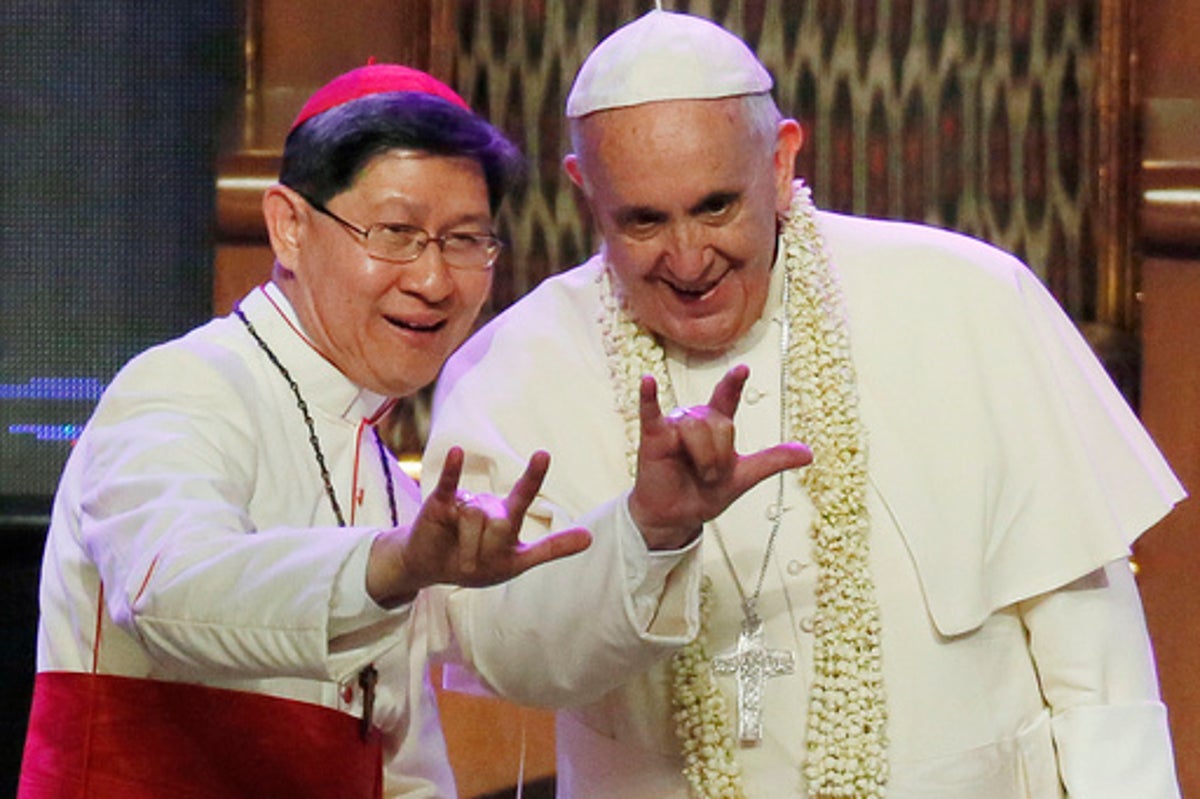Latest News
Cardinal Tagle: The youthful 67-year-old emerging as a favourite to be the next pope
Published
8 months agoon
By
cldhaz
Cardinal Luis Antonio Tagle shares more than just a warm smile and infectious laugh with Pope Francis.
Like the late Argentinian pontiff, Tagle hails from outside Europe’s traditional Catholic power base, bringing a fresh perspective to the Vatican. As cardinals convene on Wednesday for the secret conclave to elect the next pope, some believe Tagle’s similarities to Francis could position him as a frontrunner.
According to the bookmakers, Tagle is currently the second favourite to be the next pope, at odds of 5-2, just behind Cardinal Pietro Parolin, the Vatican’s secretary of state.
Tagle, who looks younger than his 67 years and likes to be called by his diminutive nickname “Chito”, has headed the Vatican’s Dicastery for Evangelization, effectively the Church’s missionary arm, for the past five years. That position gave him enormous influence over national churches in developing countries.
While 67 is a sunset age in many organisations, it is considered young in the Vatican because few cardinals want a very long pontificate.
Choosing Tagle could signal a clear intention to continue the progressive path of Francis, embracing a more open and modern Church. His potential election would indicate a rejection of candidates who might reverse some of Francis’s reforms, reassuring the world’s 1.4 billion Catholics of the Church’s continued trajectory.
It would also mean his fellow cardinals had shrugged off question marks over his management abilities.
“He would represent a continuity of what Pope Francis has been doing,” said Rev Emmanuel Alfonso, a former student of Tagle’s who has known him for decades. “He’s really like Pope Francis in terms of his love for the poor, his approachability and so on.”
Francis greets Tagle, the then archbishop of Manila, and a group of migrants, during his weekly general audience at the Vatican, September 2017 (AP)Tagle, the former archbishop of Manila, would be the first pope from what is now considered Asia, although in the early Church some popes hailed from what is now called the Middle East, technically part of Asia.
As archbishop of Manila, and before as bishop of the Philippine city of Imus, Tagle gained pastoral experience in running dioceses in Asia’s largest Catholic country. By bringing him to the Vatican in 2020, Francis gave him one more notch in experiences seen as helpful to papal candidates. Tagle’s move to Rome brought criticism from the then Philippine president Rodrigo Duterte, who oversaw a bloody “war on drugs” that killed thousands of Filipinos during his 2016-2022 administration.
Duterte said Tagle had been removed from Manila for meddling in national politics.
The Catholic Bishops’ Conference of the Philippines denied those accusations forcefully. Bishop Pablo Virgilio David of Kalookan, a conference official made a cardinal in 2024, called Duterte’s claim “unbelievably ludicrous”.
Many cardinals already know Tagle personally, and many may see an attraction in having a pope from Asia, viewed by Church leaders as an important region of growth for the faith. Young people feel comfortable with him. When Tagle hosted Francis for a visit to the Philippines in 2014, the visit drew the largest crowds in the history of papal travel, including a mass that attracted up to 7 million people.
People attend a rosary prayer service with Tagle for the health of Pope Francis in St Peter’s Square, 25 February (AP)Tagle, who speaks Italian, English, and Spanish as well as his native Tagalog, now has five years of experience of the Vatican’s arcane bureaucracy, although some cardinals may think even that is not enough to run the global Church.
One possible weakness in Tagle’s candidacy is that he was involved in a management scandal three years ago. In 2022, Francis removed him from a second job as titular head of a Vatican-based confederation of 162 Catholic relief, development and social services organisations working in more than 200 countries.
Francis fired the entire leadership of the group, called Caritas Internationalis, following allegations of bullying by top management.
Tagle’s role, akin to a chancellor of the organisation, was mostly symbolic and ceremonial. He was not directly involved in the day-to-day running and was generally admired by staffers.
Unlike Francis, Tagle enjoys a global reputation as a theologian, which could help him gain votes from moderate cardinals concerned by some of Francis’s off-the-cuff utterances, which led to what some called confusion about Church teachings.
In the 1990s, he served on the Vatican’s International Theological Commission under Cardinal Joseph Ratzinger, a German known as a strict adherent to traditional doctrine who would later become Pope Benedict XVI.
The Reverend Joseph Komonchak, Tagle’s professor at the Catholic University of America in Washington DC, said the cardinal was one of his best students in 45 years of teaching.
“Not the least of Chito’s virtues was the joy that he radiated on everyone who encountered him,” said Komonchak. “He had a fine sense of humour, which endeared him to his fellow students.”
Tagle wearing his biretta hat, after Pope Benedict XVI appointed him as a cardinal during a ceremony on 24 November 2012, at St Peter’s Basilica at the Vatican (AFP/Getty)Fr Robert Reyes, a seminary classmate who has known Tagle for more than 50 years, said Tagle has an ability to connect with people and a simple style of living. When he first became a bishop in 2001, he didn’t own a car.
“He preferred to take rides, to hitch a ride with someone driving to a place that perhaps both of them were going to,” said Fr Reyes.
What’s the geographic breakdown of the cardinals who will elect the new pope?
There is no rule that cardinals electing a new pope vote a certain way according to their nationality or region. But understanding their makeup in geographic terms can help explain some of their priorities as they open the conclave on Wednesday to choose a new leader of the Catholic Church.
A cardinal who heads the Vatican’s liturgy office might have a very different set of concerns than the archbishop of Ulaanbaatar, Mongolia. A cardinal who runs a large European archdiocese with hundreds of priests likely has other priorities than the Vatican ambassador ministering to war-torn Syria or the archbishop of Managua, Nicaragua, whose church has been under siege by the government.
There are currently 135 cardinals under the age of 80 and eligible to vote, hailing from 71 different countries in the most geographically diverse conclave in history. Already, two have formally told the Holy See that they cannot attend for health reasons, bringing the number of men who will enter the Sistine Chapel down to 133.
A two-thirds majority is needed to be elected pope, meaning that if the number of electors remains at 133, the winner must secure 89 votes.
Here is a regional breakdown of the full 135 cardinal electors, according to Vatican statistics and following the Vatican’s geographic grouping.
Europe: 53 (of whom 17 are Italian, the most of any country.) One of the electors who says he’s skipping the conclave is from Spain, so the actual number of Europeans is expected to be 52.Asia (including the Middle East): 23Africa: 18. One of the electors who says he’s skipping the conclave is from Kenya, so the actual number of Africans is expected to be 17.North America: 16 (of whom 10 are American, 4 are Canadian, and 2 are Mexican)South America: 17Central America: 4Oceania: 4 (one each from Australia, New Zealand, Papua New Guinea, and Tonga)


Widest 5G Coverage, the Launch of the Uplay Platform, and the Integration of Cerillion: Ucom Summarizes 2025

Iran reports 3 security forces, 1 civilian killed in border clash

Darts player brings insect spray on stage as wasps wreak havoc at worlds

Artsakh has no natural gas for 4th day, negotiations with Azerbaijan continue

Italy’s Palermo unanimously recognizes Artsakh independence

Captured in Artsakh terrorist says they were promised $ 100 for each severed head of ‘kafir’

NEWS.am latest, 03.11.20: Nagorno-Karabakh authorities have evidence of Azerbaijan using prohibited weapons in Artsakh

Captured in Artsakh terrorist says they were promised $ 100 for each severed head of ‘kafir’

